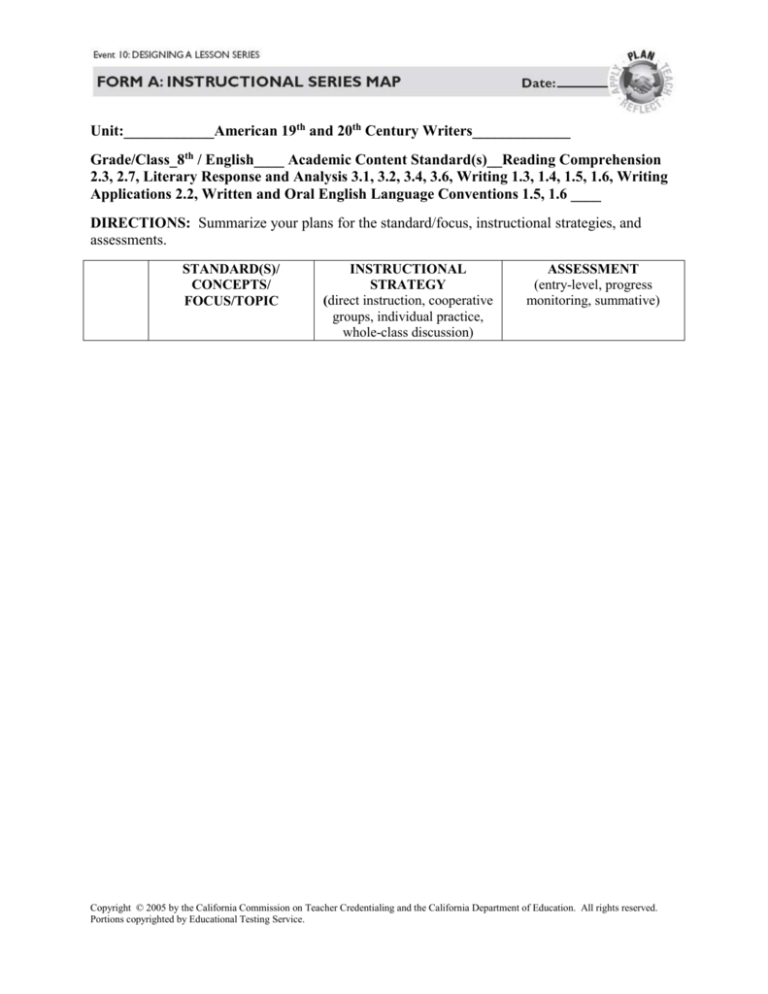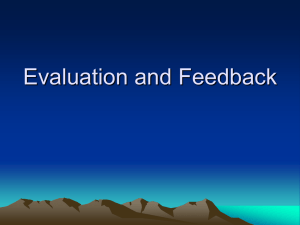
Unit:____________American 19th and 20th Century Writers_____________
Grade/Class_8th / English____ Academic Content Standard(s)__Reading Comprehension
2.3, 2.7, Literary Response and Analysis 3.1, 3.2, 3.4, 3.6, Writing 1.3, 1.4, 1.5, 1.6, Writing
Applications 2.2, Written and Oral English Language Conventions 1.5, 1.6 ____
DIRECTIONS: Summarize your plans for the standard/focus, instructional strategies, and
assessments.
STANDARD(S)/
CONCEPTS/
FOCUS/TOPIC
INSTRUCTIONAL
STRATEGY
(direct instruction, cooperative
groups, individual practice,
whole-class discussion)
ASSESSMENT
(entry-level, progress
monitoring, summative)
Copyright © 2005 by the California Commission on Teacher Credentialing and the California Department of Education. All rights reserved.
Portions copyrighted by Educational Testing Service.
LESSON PLAN
American writers of the
19th and 20th Century
(short stories, novels
passages, poetry, essays)
Direct Instruction
Homework
Whole-Class Discussion
Classwork
Group Work (analysis of
readings, answering critical
thinking questions on
readings, peer editing work)
Reading Quizzes
Writing Workshops
PowerPoint Presentation
or Brochure
Personal Essay
Individual Practice (writing
essays, literary responses,
final project with
presentation)
Copyright © 2005 by the California Commission on Teacher Credentialing and the California Department of Education. All rights reserved.
Portions copyrighted by Educational Testing Service.
DIRECTIONS: Identify the critical understandings and skills for the selected content
standard(s) which you would expect students to have prior to the lesson series you are planning.
Identify prior experiences students may have had with the standard(s).
What prerequisite skills, concepts and knowledge will students need in order to meet the
standard(s)? Information sources include classroom assessment, district assessment, and CAT6
(grades 3,7,10), STAR (grades 2-11), and CELDT.
Class:
Students should have basic note taking skills, peer editing skills, ability to analyze
literature, skills to answer critical thinking questions on readings, basic knowledge of how
to write an essay, basic Word and PowerPoint skills, and the ability to use the internet and
research engines.
English learners:
Knowledge of the five-paragraph essay structure, ability to work well with others, basic
note taking skills, basic ability to comprehend the readings, ability to answer questions on
the readings, basic computer and internet skills, and ability to conduct simple online
research.
MODIFICATIONS/ACCOMODATIONS:
English Language Learner:
More handouts of sample essays and more handouts on practicing writing thesis
statements, topic sentences, and conclusions. Also more time tutoring and help with
learning how to critically analyze work.
Special Education Student:
Same as above.
Resources you might use:
Academic Content Standards/Framework
Teacher Resources – teacher’s guides, other instructional/support materials including Specially Designed Academic
Instruction in English (SDAIE) materials.
Student Resources – student texts, charts, rubrics, activity cards, exemplars, technology applications
District Curriculum Guides/ Course of Study
Observations and discussions with colleagues with subject-matter expertise and//or SDAIE experience and expertise
Copyright © 2005 by the California Commission on Teacher Credentialing and the California Department of Education. All rights reserved.
Portions copyrighted by Educational Testing Service.
Copyright © 2005 by the California Commission on Teacher Credentialing and the California Department of Education. All rights reserved.
Portions copyrighted by Educational Testing Service.
DIRECTIONS: Complete one instructional plan for each lesson on Form A. If you use a
district lesson plan, copy and attach.
INSTRUCTION PLAN
K-12 Academic Content Standard(s):
What is the academic learning goal(s)?
Students are able to answer critical thinking
questions based upon a reading.
REFLECTION
MODIFICATIONS/ACCOMODATIONS:
English Language Learner:
The same work should be produced, there is
just a different level of expertise expected
and progress is especially looked for.
Students are able to write a literary
response to a piece of literature.
Students are able to peer edit their
classmates work.
Students are able to write a standard fiveparagraph essay.
Special Education Student:
Same as above.
Students are able to conduct online research
and create either a PowerPoint presentation
of a brochure.
Copyright © 2005 by the California Commission on Teacher Credentialing and the California Department of Education. All rights reserved.
Portions copyrighted by Educational Testing Service.
Copyright © 2005 by the California Commission on Teacher Credentialing and the California Department of Education. All rights reserved.
Portions copyrighted by Educational Testing Service.
INSTRUCTION PLAN
What instructional strategies and activities
will you use for this lesson?
Class:
Activities should be varied, because that
gives students the opportunity to be more
interactive in the classroom. Direct
Instruction, group work, individual
practice, and whole class discussion should
always be apart of a unit. Constant feedback
from the teacher is also necessary, because
then students know where they stand, what
they have to work on, and are not in the
dark about their progress.
English Language Learner modifications:
Same. But extra tutoring and helpful
materials will be provided.
REFLECTION
In what ways are your instructional strategies
and activities effective in measuring the
learning goals for this lesson?
Class:
With varied activities, students have
numerous opportunities to show their
knowledge of the skills. Also with constant
feedback and checking of work the learning
goals are effectively measured by the
teacher.
English Language Learner:
Same. But also the extra help will give these
students an opportunity to raise their
academic achievement level and get that
much closer to being on the same level as the
regular students.
Special Education Student:
Same as English Language Learners.
Special Education Student modifications:
Same as English Language Learner.
Copyright © 2005 by the California Commission on Teacher Credentialing and the California Department of Education. All rights reserved.
Portions copyrighted by Educational Testing Service.
INSTRUCTIONAL PLAN
PROGRESS MONITORING ASSESSMENT
What evidence (student work) will you collect
during this lesson that will show the extent to
which students have achieved the learning
goal(s)?
Class:
Reading Quizzes, literary responses, critical
thinking questions with answers, essay, peer
edited work, PowerPoint presentation or
brochure project, writing workshop
materials and homework.
REFLECTION
In what ways are your assessment strategies
effective in measuring the learning goals for
this lesson?
Class:
Tests their abilities on every level, whole
class, group, and individual. Large
collection of work will demonstrate their
acquired knowledge.
English Language Learner:
Same.
English Language Learner modifications:
Same, but also the extra handouts on
writing essay skills.
Special Education Student:
Same.
How might you modify assessment of the
academic content standard(s)?
Special Education Student modifications:
Same as English Language Learner.
Class:
Academic Content Standards are already
within all the classroom activities and
assignments.
English Language Learner:
Same.
Special Education Student:
Same.
Copyright © 2005 by the California Commission on Teacher Credentialing and the California Department of Education. All rights reserved.
Portions copyrighted by Educational Testing Service.
INSTRUCTIONAL PLAN
How will you group students for instruction
during this lesson? (based on reading level,
English learner level, etc.)?
The student would be placed in random
groups, so that they will be able to work
with a wide range of students.
How did you choose the group for English
Language Learner?
They will be placed in random groups,
except they will always have another
English Language Learner with them.
How did you choose the group for Special
Education Student?
They will either be placed with each other,
English Language Learners, or a patient,
high achieving regular student.
What instructional materials and technology
will you use?
Textbook, handouts, computer, paper, and
pen.
English Language Learner modifications:
Same, but with extra handouts.
Special Education Student modifications:
Same as English Language Learner.
REFLECTION
In what ways are these grouping(s) appropriate
for your students.
Class:
Gives the students a chance to work on their
cooperative working abilities, because they
will not always be able to work with people
they personally choose. Also it would give
students a chance to bond more with their
classmates and create a safer and more
comfortable classroom learning
environment.
English Language Learner:
Give these students a comfort zone, while at
the same time challenging them
academically.
Special Education Student:
Same as English Language Learner.
In what ways are the materials and technology
effective?
Class:
Materials are all provided either by the
school or by the teacher. Accessible to all
students. Computers available for use in the
classroom too.
English Language Learner:
Same.
Special Education Student:
Same.
Copyright © 2005 by the California Commission on Teacher Credentialing and the California Department of Education. All rights reserved.
Portions copyrighted by Educational Testing Service.










